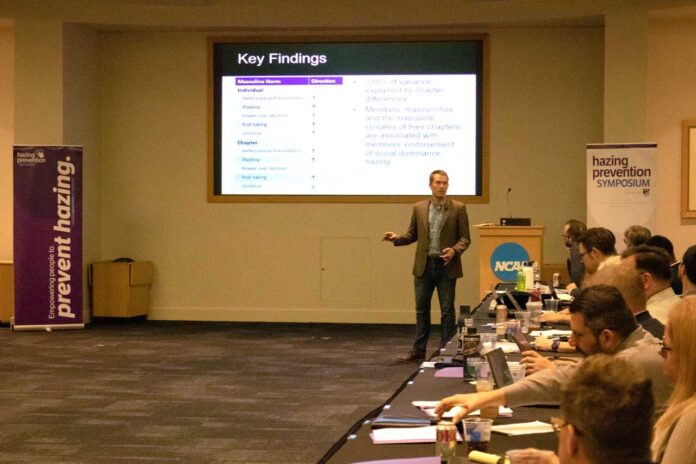Research is very important to hazing prevention. The data discovered or confirmed through research helps all of us better develop our hazing prevention programming and efforts. As student affairs professionals, you likely know that until the last decade or so, research in hazing and hazing prevention was limited. However, in the last decade, we have seen a rise in funded research projects. This summer, the Hazing Prevention Network worked with the Piazza Center to develop a gathering to encourage dialogue, share new insights, review critical perspectives, and inform new research directions in the understanding and prevention of hazing. Researchers shared key points from established research as well as new ideas and directions for future research. With this collaboration, the Hazing Prevention Symposium was created and co-hosted with the National Federation of High School Associations (NFHS).
“My overall response to the symposium is that there is strong, reliable research occurring that is providing useful implications for practice,” said participant Kerry Welch, Ed.D., who serves as Associate Vice President of Student Success and Well-Being at Central Florida University.
Researchers and participants alike listened for connections between research insights and offered suggestions and new perspectives. The outcomes of the symposium were to give an opportunity to form relationships with stakeholders and researchers, increase participants’ grasp of hazing phenomena, and develop new viewpoints to consider when approaching hazing research and hazing prevention strategies.
Kim Copeland, a hazing prevention consultant from Australia, said, “I gained some new knowledge and thought differently about some theoretical concepts while listening, which will help my future work.”
The researchers included Aldo Cimino, Ph.D., Assistant Professor of Anthropology, Kent State University; Adam M. McCready, Ph.D., Assistant Professor-in-Residence of Higher Education and Student Affairs in the Neag School of Education at the University of Connecticut; Gentry McCreary, Ph.D., CEO, Dyad Strategies; Jason Meriweather, Ph.D., Author, Dismantling Hazing; Emily Perlow, Ph.D., Associate Dean of Students, Worcester Polytechnic Institute; Pietro A. Sasso, Ph.D., Associate Professor of Higher Education Leadership, Delaware State University; and Stevan Veldkamp, Ed.D., Executive Director Piazza Center.
Aldo Cimino presented a persuasive case for a collective definition of hazing, emphasizing the need for a more robust understanding of the phenomenon. He asserted that both researchers and practitioners benefit from choosing a definition. Practitioners need an explicit definition to talk with students, and researchers need an explicit definition to frame literature reviews, apply and evaluate theories, select appropriate measures, and have conversations about hazing.
Cimino also shared data from a study that explored the relationship between solidarity and hazing in a fraternity chapter. Using the solidarity macro theory, the study measured new members’ feelings of solidarity and how they perceived induction fun and harshness in their fraternity over a 10-week induction period. “Fun” activities led to significant increases in measures of solidarity (liking, coordination, communal strength, and closeness) with other new members and the active members, but “harsh” activities had little relationship with the solidarity measures.
Further, Cimino investigated how measures of solidarity predicted induction attrition. The study found that both induction harshness and chapter communal strength had a positive relationship with induction attrition. However, there was a negative interaction between induction harshness and chapter communal strength, suggesting that members of chapters with harsher inductions perceive lower levels of chapter communal strength.
Gentry McCreary’s presentation expanded on Cimino’s research and focused on the role of social dominance in hazing activities. Social dominance is one of several hazing motivations that McCreary and colleagues measure in their research, and McCreary presented trend data about hazing motivations over the last five years (2018 to 2022). Several of their other hazing motivation measures (solidarity, loyalty/commitment, and instrumental education) have remained relatively steady over the period under study, but beginning in 2020, social dominance motivations have increased in both fraternities and sororities and have not regressed back to pre-pandemic levels.
McCreary also introduced the concept of political ideology and its potential impact on hazing motivations. The most pronounced trends were in the social dominance and loyalty/commitment motivations, where members identifying as “very liberal” measured lowest and members identifying as “very conservative” measured highest. Moreover, measures of hazing tolerance increased as political ideology ranged from “very liberal” to “very conservative.” McCreary noted that hazing interventions should be multi-layered and must extend beyond the “what” of the behaviors into the “why” and “who,” and targeting political ideology could help reduce hazing incidents.
Adam McCready explored the connections between fraternity contexts and masculine norms. He shared and summarized findings from several of his most recent and forthcoming national studies about fraternity men and hazing. In one of his studies, he noted that over a three-year period there were no significant differences with regard to social dominance, endorsement of hazing, and conformity to forms of masculinity over time. There was a decline in conformity to power and gender (heterosexual) presentation. McCready also explored the connection between masculinity and hazing, highlighting predictors of social dominance. He found that more severe forms of hazing were not linked to less severe forms, indicating the need for comprehensive prevention strategies.
Overall, he suggested that there is a need for a more longitudinal approach and perspective in examining hazing. It was purported that this change over time should examined beginning in K-12, especially in high school. He indicated that high school to college study should be conducted to better understand the etiology of how hazing transcends higher education spaces.
Jason Meriweather discussed the progression from minor forms of hazing to riskier forms across different contexts, emphasizing the importance of understanding the continuum of hazing behaviors. Through his examples and storytelling, a description of benign traditions unfolded into more serious hazing incidents. Meriwether’s review of legal case histories informed a practical lens for campus and organizational culpability, transparency, and a movement toward prevention practice.
Emily Perlow presented the Piazza Center Horizontal Hazing Model. The Model notes that there is a complex interplay of individual, organizational, and group norms and values that contribute to hazing culture. Individual perceptions, organizational values, organizational performance, and community values influence each other, including how individuals and organizations challenge and contribute to norms and cultures.
Perlow spoke about the “play frame” where hazing occurs with fraternity men, then she discussed the Situational Strength Model, which describes how external cues (implicit or explicit) about behaviors can make situations weak or strong. In strong situations, participants construe events the same way and have uniform expectations about how to respond. Perlow described the Four C’s of Situational Strength: Clarity (the degree to which certain cues in the environment are available and easy to interpret), Consistency (the degree to which cues in the environment are compatible with one another), Constraints (the degree to which a person/organization can freely choose a course of action), and Consequences (the extent to which individual or organizational behaviors result in impacts to the individual or organization).
Finally, Perlow offered strategies for disrupting situational strengths that contribute to hazing behaviors. Students can be involved with these strategies through peer norming, anti-hazing messaging from respected student leaders, and peer-created anti-hazing messaging. Institutions and organizations can provide consistent messaging from coaches and stakeholders and offer tools for replacing hazing activities. Moreover, having a clear definition of what is considered hazing, rewarding groups that do not haze, providing clear reporting channels, and defining transparent consequences for hazing can help disrupt the stronger situations and discourage hazing.
Stevan Veldkamp provided an update on the Piazza Center’s Hazing and Hazardous Drinking Study, highlighting the challenges and opportunities in hazing prevention. He emphasized the importance of assessment mapping, assurance, capacity, and saturation in developing effective prevention strategies.
Pietro Sasso introduced the Piazza Center Hazing Prevention Matrix as a tool for designing comprehensive hazing prevention programs. Sasso reviewed levels of programs, their efficacy, and whether they could be used in combination with other programs. In line with the Piazza Center Horizontal Hazing Model (presented by Emily Perlow), the Matrix includes individual, group/organization, and community level programs. This presentation focused on the individual and group/organization levels.
First, Sasso’s presentation covered individual interventions that can help students recognize warning signs of hazing and intervene when necessary. Sasso discussed bystander intervention, brief motivational interviewing, parental notification, educational sanctions, and bullying/harassment/intimidation (HIB) training as strategies that can be used at the individual level. He also provided examples of how these interventions have been applied to other social issues (e.g., alcohol use and drug use) and forms of violence (e.g., bullying and sexual violence).
Next, he discussed group/organization programming, which are often large-scale programs delivered as a singular event. These programs, such as video workshops and reflection, speakers, policy/law education, and programs by peer leaders/educators, focus on group accountability and seek to change cultures and climates that tolerate hazing. He noted more recent research which suggested that campus moratoriums or a “pause” does not results in the desired outcomes related to reducing hazing or campus culture change. Sasso offered strategies for implementing these programs and shared research about how these group/organization programs have been applied to preventing hazing and other types of violence.
The symposium included with a panel discussion featuring Aldo Cimino, Gentry McCreary, and Adam McCready, who shared ideas for prevention based on emerging studies. They each offered specific perspectives about hazing, pertaining to its etiology and future directions. Presenters also offered their concluding thoughts. Sasso summarized last and noted that the future of addressing hazing rests with our students and that any future cultural change is connected to their capacities to enact peer accountability and facilitate programs that directly connect with Generation Z. He noted that the greatest programmatic efficacy is with peer-to-peer programs that are delivered with fidelity.
Overall, the symposium provided valuable insights into the understanding and prevention of hazing. It fostered collaboration between researchers and leaders and offered new perspectives and strategies for addressing this issue. The symposium’s outcomes included forming relationships with stakeholders, increasing participants’ understanding of hazing, and developing new viewpoints for future research and prevention strategies.
About the authors:
Todd Shelton has a breadth of experience as an award-winning nonprofit communicator and volunteer. He serves as the executive director for the Hazing Prevention Network and separately provides communication strategy guidance to a variety of organizations. He previously served as the Chief Communication Officer at the North American Interfraternity Conference. Shelton has served in several volunteer roles including President of the Fraternity Communications Association and Assistant Executive Director of the Southeastern Interfraternity Conference. He is a member of Kappa Alpha Order from Middle Tennessee State University and a Tennessee native living in Indianapolis, Ind.
Kimberly Davis, Ph.D., serves as the Piazza Center Data Analyst working on an array of research projects to curb hazing and increase student’s well-being. Davis earned her bachelor’s degree from Mercer University, where she joined Alpha Gamma Delta, and earned her master’s degree from Arkansas Tech University. Davis received her doctoral degree in the Higher Education Administration program at Louisiana State University, and her doctoral study focused on the influence of organizational and institutional culture on hazing in historically White fraternities. Davis is a frequent presenter at national higher education and student affairs conferences and was a co-author of the 2020-2025 National Leadership Education Research Agenda. Prior to Penn State, Davis previously worked in housing and residence life, fraternity/sorority life, student conduct, and Title IX at Centenary College of Louisiana, the Louisiana School for Math, Science, and the Arts, and LSU.
Pietro A. Sasso, Ph.D., is an Associate Professor in Educational Leadership at Stephen F. Austin State University where he also serves as the director of the Center for Research Advancing Identities & Student Experience (RAISE Center). He additionally serves as the faculty research fellow for the Piazza Center in which he supports the dissemination of interdisciplinary research projects as scholarly peer-reviewed journals and presentations at national conferences. He has previously worked as a fraternity/sorority professional in both inter/national and campus-based professional capacities. Dr. Sasso has written and edited more than 20 publications related to the fraternity/sorority experience including 3 seminal texts. In total, he has co-edited 10 textbooks, authored approximately 60 scholarly publications, and facilitated over 100 conference presentations. He serves as a reviewer for more than 5 journals including the Journal of Student Affairs Research & Practice and serves as senior co-editor for the text series Identity & Practice in Higher Education-Student Affairs by Information Age Publishing. He is the recipient of the AFA Dr. Charles Eberly Research Award and is a past ACPA Men and Masculinities Emerging Scholar-In-Residence.
Stevan “Steve” Veldkamp, Ed.D., is executive director of the Timothy J. Piazza Center for Fraternity and Sorority Research and Reform, and is dedicated to improving the safety and experience of fraternity and sorority members on campuses across the country. The Piazza Center is a national multidisciplinary research center that provides actionable evidence to practitioners in the field. Prior to his current role, Steve served as the Assistant Dean and Director of Student Life and Learning at Indiana University Bloomington. He has also held positions at Western Michigan University and the University of Wisconsin Eau Claire. Steve is a two-time graduate of Grand Valley State University and he received his doctorate in Higher Education and Student Affairs from Indiana University Bloomington. Steve is a proud first generation college student and a member of Sigma Phi Epsilon Fraternity.



